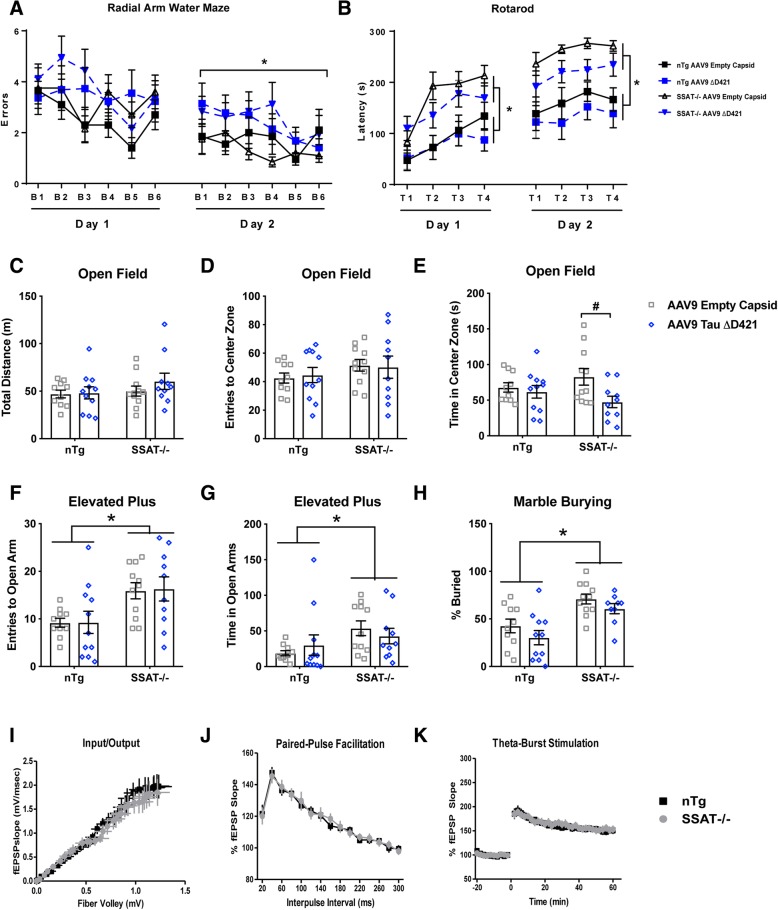Fig. 8.
AAV9 Tau ΔD421 produces cognitive impairment; SSAT disruption produces behavioral phenotype. a Radial arm water maze errors for per block and per day of 15-month-old nTg and SSAT-/- mice administered either AAV9 empty capsid (EC) or AAV9 Tau ΔD421 (n = 9–11). Simple main effects analysis showed that AAV9 Tau ΔD421 significantly increased errors (F(1, 36) = 5.204, p = .029) on day 2 of the radial arm water maze (RAWM). No effect of genotype (F(1, 36) = 1.521, p = .225), AAV9 Tau ΔD421 (F(1, 36) = 3.196, p = .082), or interaction of factors (F(1, 36) = .392, p = .535) was found on errors on day 1 of RAWM. No effect of genotype (F(1, 36) = .051, p = .822) or interaction of factors (F(1, 36) = .525, p = .473) was found on errors on day 2 of RAWM. Repeated measures mixed analysis of variance (ANOVA), *p < .05. Data is represented by means ± S.E.M. Asterisks indicate the main effect of treatment. b Rotarod performance latency per trial and per day of 15-month-old nTg and SSAT-/- mice administered either AAV9 empty capsid (EC) or AAV9 Tau ΔD421 (n = 9–11). Simple main effects analysis showed that SSAT disruption significantly increased latency to fall on day 1 (F(1, 37) = 14.164, p = .001) and day 2 (F(1, 37) = 19.626, p = .000) of the rotarod task. No effect of AAV9 Tau ΔD421 on day 1 or day 2 (F(1, 37) = .779, p = .383; F(1, 37) = 2.985, p = .092), respectively), or interaction of factors on day 1 or day 2 (F(1, 37) = .080, p = .779; F(1, 37) = .149, p = .702, respectively) was detected on rotarod latency to fall. Repeated measures mixed analysis of variance (ANOVA), *p < .05. Data is represented by means ± S.E.M. Asterisks indicate the main effect of genotype. c–h Behavioral assessment in the open field, elevated plus maze, and marble burying tasks of 15-month-old nTg and SSAT-/- mice administered either AAV9 empty capsid (EC) or AAV9 Tau ΔD421 (n = 9–11). 2 × 2 Factorial analysis of variance (ANOVA), followed by pairwise comparisons using Fishers PLSD. *p < .05; Asterisks indicate the main effect of genotype and number signs indicate the pairwise comparison within genotype. Data is represented by means ± S.E.M. c–e Open field: Simple main effects analysis showed no effect of SSAT disruption on total distance traveled (F(1, 38) = 1.488, p = .230), number of entries to the center zone (F(1, 38) = 1.825, p = .185), or time in the center zone (F(1, 38) = .001, p = .970). While there was no effect of AAV9 Tau ΔD421 on total distance traveled (F(1, 38) = .844, p = .364) or number of entries to the center zone (F(1, 38) = .007, p = .935), there was a main effect of treatment on time in the center zone in that AAV9 Tau ΔD421 significantly decreased time in the center zone (F(1, 38) = 5.065, p = .030); however, pairwise comparisons revealed this effect was only present in SSAT-/- mice (p = .01), suggesting a modest interaction of genotype and treatment on anxiety-like behavior as measured by this task. f, g EPM: Simple main effects analysis showed that SSAT disruption significantly increased entries to the open arm (F(1, 38) = 11.894, p = .001) and time in the open arm (F(1, 38) = 4.892, p = .033). No main effect of AAV9 Tau ΔD421 (F(1, 3) = .014, p = .908; F(1, 38) = .001, p = .982, respectively) or interaction of factors (F(1, 38) = .006, p = .937; F(1, 38) = 1.070, p = .307, respectively) was detected on EPM open arm entries and open arm time. h Marble burying: Simple main effects analysis showed that SSAT disruption significantly increased percent of marbles buried (F(1, 37) = 20.576, p = .000). No main effect of AAV9 Tau ΔD421 (F(1, 37) = 3.034, p = .090) or interaction of factors (F(1, 37) = .029, p = .866) was detected on percent marbles buried. i–k Comparing nTg and SSAT-/- mice (n = 6), normal input/output curve at Schaffer collateral/CA1 synapses was observed. Nonlinear regression, line fits were compared using the extra sum-of-squares F test for the Fiber volley (p = 0.4907) and fEPSP (p = 0.1019), respectively. No difference was seen in short-term presynaptic plasticity measured by paired-pulse facilitation (PPF), (F(1, 48) = 0.010, p = 0.920.) LTP was induced in nTg and SSAT-/- slices using a theta-burst stimulation protocol and no significant differences were seen in the induction or maintenance of LTP in SSAT-/- compared to nTg slices (F(1, 12) = 0.642, p = 0.439)

